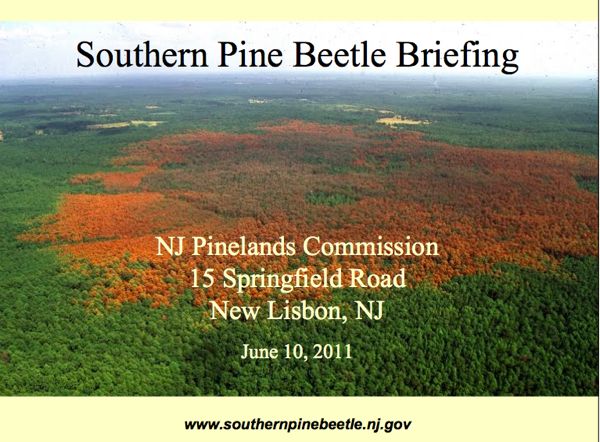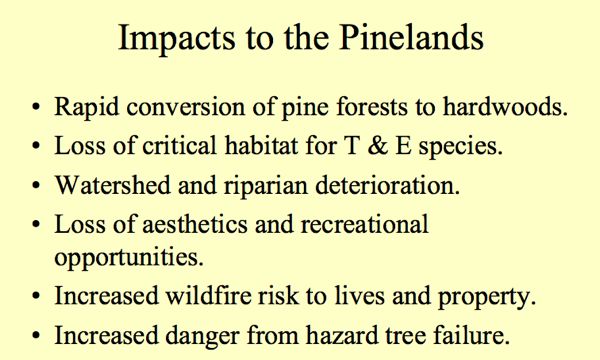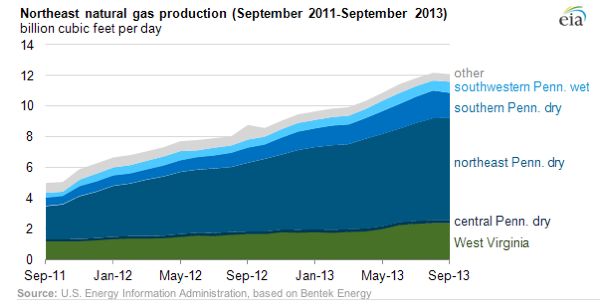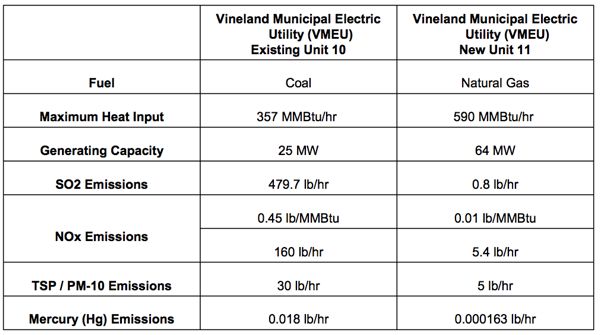Climate Change Already Impacting Pinelands Forests
Despite Denial By Some Leaders at the NJ Pinelands Commission and NJ DEP
Wolfe argued the effects of fossil fuel should figure into the commission’s decision.
“The effect of climate change on forests is well documented” in the Pinelands and elsewhere, he said.
“Our standards don’t directly deal with it,” Witteneberg (sic) affirmed Thursday.
The Pinelands plan was written at the beginning of the 1980s, before climate was widely seen as an issue, and “as much as they (critics) like to say we have the means to do that, I’m not sure we do,” she said. ~~~ Asbury Park Press, 10/18/13
Lets take a look at what the science says about climate change impacts on forests, from the international; to the US; to the regional Pinelands scales – in that order – in light of Director Wittenberg’s denial:
I) IPCC Climate Change Impacts on Forests
1.5.4.3. Pests and Pathogens
Warming in winter may allow destructive insects and pathogen- ic fungi to survive at higher latitudes than at present, enabling subtropical or warm-temperate pests and pathogens to invade vegetation from which they are now excluded (Dobson and Carper, 1992). Some insects also will be able to complete more generations per year in warmer climates. Increased incidences of pests and diseases may further limit the growth of stands that are already declining from the effects of climate change or pol- lution. Summer droughts and other climatic stresses have been associated with outbreaks of bark beetles like the southern pine beetle (Dendroctonus frontalis) in southern parts of the United States, bark beetles in western Canada (Kimmins and Lavender, 1992), and bronze birch borers on paper birch in northern Michigan (Jones et al., 1993). Elevated CO2 can change the palatability of leaves and either promote or discourage insect herbivory (Overdieck et al., 1988; Mueller-Dombois, 1992). In areas where forestry practice has led to the establishment of mono-specific stands, forests are particularly vulnerable to out- breaks of pests and diseases, especially where that combines with poor site quality or exposure to industrial pollutants.
II) US Forest Service: Effects of Climatic Variability and Change on Forest Ecosystems: – A Comprehensive Science Synthesis for the U.S. Forest Sector
See Box 2.3 – The Southern Pine Beetle Reaches NJ Pinelands
The northern distribution of southern pine beetle is constrained by the occurrence of lethal winter temperatures (cite). As part of the first National Climate Assessment, it was estimated than an increase of 3 degrees C in minimum annual temperature would permit a northern expansion of about 180 km for this beetle. In fact, there was a regional increase of just over 3 degrees C from 1960 – 2005, and beetle populations are now endemic in the NJ Pinelands, about 200 km north of frosts with a long history of such epidemics.
III) NJ Department of Parks & Forestry fact sheet:
Since 2001, SPB populations in New Jersey have been on the rise, destroying 1000 new acres of pine forests each year on average, but infestations remained largely confined to the southern sections of the state. Then, in 2008, SPB crossed the Egg Harbor River for the first time and entered the pine forests of Atlantic County, and continues to move north and west.
In 2010, New Jersey experienced the warmest growing season on record (average temperature 68.3°F) and below-average precipitation. These conditions quickly advanced SPB’s range and damage levels. SPB entered the heart of the New Jersey Pinelands – designated as the nation’s first National Reserve by Congress in 1978, and a Biosphere Reserve in 1983 by the United Nations Educational, Scientific and Cultural Organization. According to USDA Forest Service estimates, 80% of the pine forest could be impacted by SPB within the next 10 years if no action is taken.
So, it sure looks like the international, national, and regional science has measured impacts and projected even more severe impacts, in conflict with Director Wittenberg’s assessment.
Who are you going to believe? The scientists or Director Wittenberg?
If Director Wittenberg is correct and the NJ Pinelands Comprehensive Management Plan (CMP) and regulations have not kept pace with the science, then the plan and regulations must be updated before huge new damaging major greenhouse gas emission sources and regional fossil fuel infrastructure projects are rubber stamped, in direct contradiction of what the science is telling us must be done.
[End Notes – Just to clarify:
1. Of course, this post just scratches the surface of a broad range of climate change impacts on the Pinelands. Pines forests and ecosystems are sensitive to water, something we’ll look at in future posts.
2. The staff understand this science. The leadership of the Pines and DEP are merely following orders of Gov. Christie’s office to deny the problem and rubber stamp corporate energy schemes cooked up by the supporters of the Governor.
3. PPA has essentialy surrendered – and without even mentioning the climate change cause!
If warmer winter temperatures continue, we may not be able to completely resist the northern range expansion of the SPB and, in that case, we would need to accept its new role in our local ecology. The pine forests would likely benefit if we also accept that high-intensity fire through prescribed burning should be restored as a natural disturbance process.




